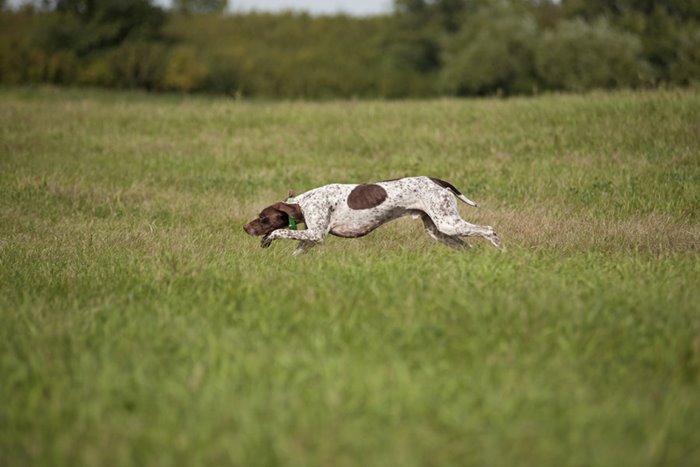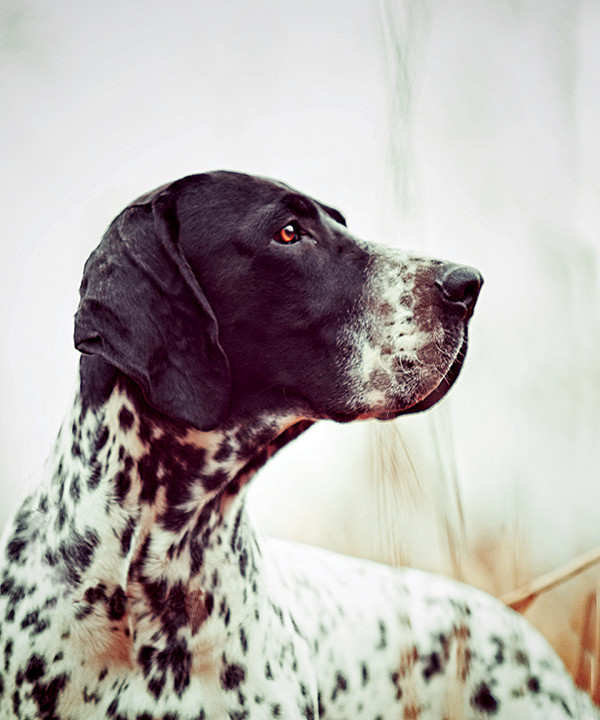The story of the Braque breeds, as well as the origin of today’s modern pointers, is intertwined with the history of the western Pyrenees Mountains, a contentious region frequently divided and conquered throughout the Middle Ages. Ancient French literature, as early as 1500, references a dog with a natural pointing instinct, one that would remain low and still, allowing hunters to cast a net over birds hiding a few feet ahead. Despite these textual allusions during the 16
th century, some experts suggest the breed could have originated centuries earlier, during the Kingdom of Navarre, a period rife with war, fratricide and struggles for maritime power.
From 1162 until the early 1500s, monarchs fought to control coastal Navarre in an effort to establish trade routes between England and Western Europe. Sequentially, on the outskirts of conflict, throughout countryside teeming with feathered quarry, hunters sought to establish a dog breed with a keen sense of smell and a physique sturdy enough to endure varied conditions. Most breed historians argue anatomical evidence dictates the Spanish pointer preceded the French, though all agree an array of hounds served as the source.
Still, some hold the opinion the Braque Francais is primarily responsible for the genetics found in modern-day pointing breeds. Perhaps it is a matter of who controlled key trade routes, and thus held influence over the region, when breeders embarked on developing a pointing-style dog. Perhaps the truth remains tucked away in the pages of an ancient text collecting dust. One thing is for certain: following the Late Middle Ages, appreciation for this versatile dog—one that could point, flush, retrieve and even trail game—grew throughout France, and many hunters started to specialize during breeding in order to meet the needs specific to their region of the country. Various Braque breeds, named after their region of origin, remain popular today among hunters both in Europe and the United States, though breeds such as the Braque de L’Ariege and the Braque Saint-Germain are still rather uncommon in North America. What follows are brief profiles of three popular French pointers.
THE BRAQUE FRANCAIS
The French pointing breed originated in southern France as early as the 1300s, some sources suggest, and was referred to as “Braque du pays,” meaning “country Braques.” Over a few centuries, populations of Braques became isolated throughout different regions and eventually developed different looks and hunting styles. During the late 1700s and early 1800s, with the advent of the industrial revolution, French society transitioned from a landscape dominated by rural agriculture to a setting concerned more with urban industry. Demand for a smaller breed capable of living in an urban setting grew among hunters. By the early 1900s, the Braque Francais was divided into two distinct breeds: the closer-working, larger “Grande Taille” (later renamed “Gascogne” in 1975) and the smaller, more compact “Petite Taille” (later renamed “Pyrénées” in 1975).

The Braque Francais Pyrenean, as termed by the American Kennel Club, is the most common Braque Francais breed in the United States currently. Seth Leyendecker of
Brielle Kennels acquired his first in 2010. His grandfather was a breeder of German Shorthaired Pointers, so Leyendecker acquired a passion for pointing breeds at an early age. He knew eventually, when he grew up, he would want to follow in his grandfather’s footsteps, though his destiny regarding GSPs proved dubious later in life. “When my wife and I were dating, a lot of dates were ruined over [German shorthaired] issues,” he said, “meaning one ran away, broke out. Different issues came up, so she said, ‘you will never own one of those.’”
Leyendecker spent nearly 3 years researching then waiting for his perfect breed of dog. “There are a lot of great breeds but I think it's important to find the one that captures your heart,” he said. “How affectionate and calm [the Braques Francais] are in the house coupled with enjoyable production in the field is hard to match. Top that with trainability and good looks is what made me fall in love with this breed.” Leyendecker and his wife’s admiration for the breed grew exponentially when they witnessed how well the dogs behaved around kids, so they decided to start their own kennel and now currently own five Braques Francais and are planning on acquiring a sixth this summer.
A Braque Francais Pyrenean typically weighs 40 to 55 pounds. The dog measures between 19 and 23 inches, on average, and its soft shorthaired coat is chestnut brown, either solid or mixed with white, or sometimes white with or without ticking, roaning or tan markings. In the field they are a fast dog that covers a lot of ground. “While I would consider them, as a whole, a medium-ranging pointing dog, they check back in so often most people would say they are close working,” Leyendecker said. “They hunt with you and for you.”
Braques Francais are very adaptable to different cover and birds, and most are light on their feet with good endurance, according to Leyendecker. In general, they are a softer breed, meaning heavy-handed techniques are not going to be nearly as effective as with some other breeds. “Some have stronger retrieve drives than others—all will, some love to,” Leyendecker said. “I find, with my dogs, if the bird is easily recovered by human, they’re fine with that. If it’s harder to get to, they are more willing to help.”
In regard to their sense of smell, Leyendecker said he would put his dogs’ noses up against any other breed. “My dogs will point more than I am able to shoot,” he said. “They have an ability to find birds—that is for sure.”
THE BRAQUE BOURBONNAIS
An illustration by Italian naturalist Ulisse Aldrovandi from the 1500s depicts a dog resembling the appearance of the modern-day Braque Bourbonnais. It is titled
Canis sagax ad coturnices capiendas pantherinus, which means “keen scented [spotted] dog for catching quail.” In one of his manuscripts, Aldrovandi also mentions a Canis Burbonensis (meaning “dog from Bourbonnais”), thus providing evidence establishing the Braque Bourbonnais as one of the oldest short-haired pointing breeds.
Like most French pointing breeds, the Braque Bourbonnais is named after the region from which it originated. Through the dedication of early French breeders following two devastating world wars, the Bourbonnais survived extinction and remains firmly established in its native country and present in the United States, among several other countries. The dogs stand typically between 19 and 22 inches tall and. on average. weigh 35 to 49 pounds for females, and 40 to 55 for males. Their coats are short and fine, typically white with fine brown or fawn ticking.
Cindy Petkwitz is the secretary of the Braque du Bourbonnais Club of American and co-operates
Aspen Ridge Kennels with her husband, Mike. Cindy and Mike hunt pheasant in South Dakota but typically put their dogs on grouse and woodcock in Michigan. “Our dogs run on Garmin and run silent,” Cindy said. “Our dogs range between 40 and 250 yards and will always check in. If they go on point, they stay on point until we get there, even after a wild flush.”
They have an excellent sense of smell, according to Cindy. “We go and hunt, if I come out of a field and there is nothing there, there is nothing there, no birds, I trust them that much.
“If you get a shorthair, they hunt anything, kill and bring it back,” Cindy said. “These are upland bird dogs. They do hunt rabbits with them in France. The dog will point it and bring it back, but they are not high prey-drive bird dogs. They love to run in the field and hunt but also love to sit next to you in house.”
Braques du Bourbonnais love their family and are often protective but will always warm up to strangers. “The key is to socialize them,” Cindy said. “They’re a rare breed and people think you can train them like any other dog but you have to take your time. You can ruin them because they are sensitive.” Because of the breed’s high level of both intelligence and sensitivity, Cindy and Mike employ the West/Gibbons training method. “We very seldom talk to them while we are training,” Cindy said. “We let the birds train the dogs and that is how we finish our dogs.”
THE BRAQUE D’AUVERGNE
The Braque d’Auvergne originated in the mountainous region of Cantal, in the historic province Auvergne in mid-south France. A strong, sturdy dog, the Braque d’Auvergne measures between 21 and 25 inches at the withers. With its large head, long ear and pendulous lips, its face somewhat resembles that of a hound. Its short, glossy coat is typically white with black mottling and/or large black spots. On average, females stand between 20 and 24 inches and weigh 55 to 60 pounds; while males stand between 22 to 26 inches and weigh between 60 and 65 pounds.

David and Rosyln Johe, Pheasant Forever members and owners of
Braque d’Auvergne Chenil d’Allegheny, owned German Shorthaired Pointers for a large part of their hunting years. In 1997, they read an article in Gun Dog Magazine about Braques d’Auvergne, which sparked an interest in the breed. In 2000, they picked up their first dog from a breeder in Alaska. “They have different personalities than GSPs,” David said. “They always want to be with you, want contact with you in the same room.”
David describes the dog as a cross between a hound and a GSP. “They have bigger jowls,” he said. “They are very good with scent. When they’re hunting, they have a neutral gait—they jump up and instead of run. As they’re jumping, their jowls and upper lips flap, which helps them pick up scent.”
Over the years, David and Rosyln have owned a total of 11 Braques d’Auvergne, having imported from Hungary, Poland, France and England. Because the breed is fairly rare, even worldwide, as part of their research, the Johes have utilized a
virtual pedigree breeding database in order to how to best proceed with their breeding program.
“The defect of these dogs, because they started with 20 dogs, there is some hip dysplasia,” David said. “If buying, make sure both parents have hips certified.”
The Braque d’Auvergne don’t tend to range far, maximum 40 or 50 yards, according to the Johes. “Then they check back,” David said. “They want to stay close. I’m older and I like that. Our dogs probably pointed 30 to 40 pheasant last year, though I didn’t hit every one of them.”
Braques d’Auvergne are good hunters for training. They swim well if introduced to water at an early age, but hunt best with temperatures around 50 degrees Fahrenheit. They respond well to positive rewards, not negatives. “These dogs will shut down if you’re mean to them,” David said. “They don’t like that; they want to be your friend.”
The breed is highly intelligent, able to learn upwards of 60 words if trained properly. Some puppies from the Braque d’Auvergne Chenil d’Allegheny have gone on to serve as therapy dogs. “We got an email back from a person whose child had epilepsy, was both mute and deaf,” David said. “When the kid has a seizure, the dog goes wild, starts barking, as it has been trained dog to help with this child.”
Because they are not natural retrievers, owners must work on that aspect during training. “Like any dog, you start young and start early,” David said. “Put your hand in their mouth, develop a soft mouth. There is a lot of work necessary to get a great dog, but it starts with a foundation—obedience, working with a lead at 7 months old.”
Jack Hennessy is a freelance outdoors journalist based out of Minneapolis and the author of the blog “Braising the Wild.” Follow him on Twitter and Instagram: @WildGameJack or on Facebook at Facebook.com/BraisingtheWild.